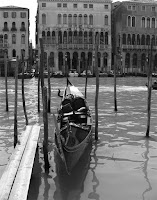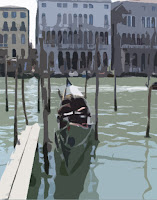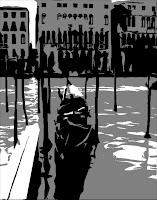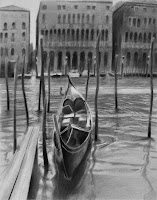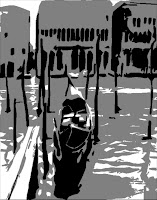
Cape Trafalgar Reggae (1995)
24.5" x 19.5" Pastel on Rembrandt Pastel Board
copyright Katherine Tyrrell
24.5" x 19.5" Pastel on Rembrandt Pastel Board
copyright Katherine Tyrrell
This is a very early pastel of mine, done while I was on a painting holiday in Spain with pastel artist Jackie Simmonds. It's of the interior of the beach hut at Cape Trafalgar (as in 'Battle of.....') which is a headland on the Costa de la Luz, south of Cadiz in the Andalucian region of Spain - very close to Morocco and the coast of North Africa.
The title comes from the fact that I was listening to Bob Marley reggae music playing in the back ground virtually the whole time I was doing this pastel which was great!
You may notice a certain 'list' to the right in this piece.! ;) The reason for this is twofold:
- I didn't do a thumbnail sketch before I started and didn't identify the perspective issues I needed to deal with. (The reasoning being that if I had stopped to think about it I probably wouldn't have tried to do the full painting as it was so complicated - and time was limited!)
- the beach cafe had a definite tilt - but it wasn't as bad as I had it.
- I wasn't using an easel and I also hadn't worked out at that stage ways of compensating for the lack of an easel.
I never normally take an easel with me on my travels (I have to strictly limit how much weight I carry and how it is distributed to avoid falls as I tend to end up on crutches for six weeks). However I have worked out how to work round this problem. What I now do when working 'plein air' is as follows:
- find somewhere where I can sit (essential as my limit for standing still tends to be around 15 minutes)
- find another chair and reverse it so it sits with its back just in front of the chair I sit in
- lean lightweight drawing board/foam core sheet (the latter is ideal for air travel) on the back of the chair
- if the chair is plastic place a garment over the back of the chair to avoid the board slipping
- the bottom of the board now sits in my lap and I adjust the distance between the seats to get the incline the way I want it
I also try and reduce the size of sheet I work on - although working large for a while was a very definite factor in learning how to loosen up my drawing.
 This is the photo taken at the end of the pastel painting against the subject. It's always interesting to take a photo like this - not least because if you've got the values anywhere near correct while working plein air it clearly demonstrates the difference between the value and colour of the shadow as you saw it and how dark it becomes in a photograph.
This is the photo taken at the end of the pastel painting against the subject. It's always interesting to take a photo like this - not least because if you've got the values anywhere near correct while working plein air it clearly demonstrates the difference between the value and colour of the shadow as you saw it and how dark it becomes in a photograph.For a really great discussion about the value of reference photos - and whether they are a help or a hindrance see Michael Chesley Johnson's recent post on this topic.
For those interested in developing their pastel work or a painting holiday I can certainly recommend Jackie very highly - and I see from her website that she is offering a painting holiday in Ithaka again in May. This is the link to a WC thread reviewing the same holiday in 2005. You can see photos and read about the experience of others.
(PS And the reason you're getting old artwork is that I keep messing up the tulip drawing!)
Links:
- Michael Chesley Johnson: A Plein Air Painter's blog - Reference Photos - help or hindrance
- Jackie Simmonds - Painting on the Greek Ionian Island of Ithaka 12-19 or 12-26 May 2007
Technorati tags: art, painting holiday, pastel, pastels,













